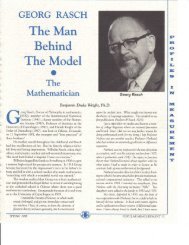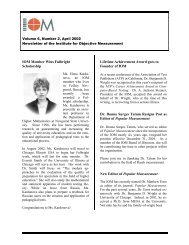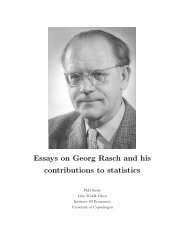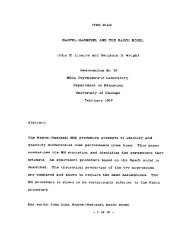Memo # 1964-2 PDF - Verio
Memo # 1964-2 PDF - Verio
Memo # 1964-2 PDF - Verio
You also want an ePaper? Increase the reach of your titles
YUMPU automatically turns print PDFs into web optimized ePapers that Google loves.
And of course the same holds for a - answer to i. This is a<br />
specification of the statement that the answers to i and j are<br />
stochastically independent.<br />
Assumption 3, however, requires still more.<br />
First it requires for each subject that the answers to all questions<br />
should be stochastically independent. Technically this is expressed<br />
in the equation<br />
(3.16)<br />
p { (4.1 ) (+2 ), „ „ „ (4. 1c )i. p {(+1 p {(42 )} „ „ „p{(k)}<br />
and all its analogues. The content of this statement is that<br />
the probability of a certain answer to an item or of a combination<br />
of answers to a set of items is unaffected by the answers given to<br />
the other items.<br />
In its full scope assumption 3) requires that the probabilities<br />
corresponding to any combination of subjects and items should be<br />
unaffected by all the other answers.<br />
4. Comparison of two items.<br />
As an introduction to the more general treatment of the model in<br />
section 5 we shall consider how two items may be compared.<br />
According to (3.11) and (3.3) the probability of correct answers<br />
to both item i and item j is<br />
(4.1 )<br />
pf(!) (+)k) , = p f(+) klp {,(+ )1 0<br />
2 E.E<br />
1 j<br />
{<br />
for a subject with the parameter E. Similarly<br />
(4. 2 ) 14* , (1)k) _<br />
(1 -1- C i )( 1 -1- C j )<br />
(4. 3) {.(<br />
1)4)k} -<br />
:<br />
(4.4) p {(i),(1)10<br />
1<br />
(11-c i)(1+E i )<br />
•<br />
With the notations









